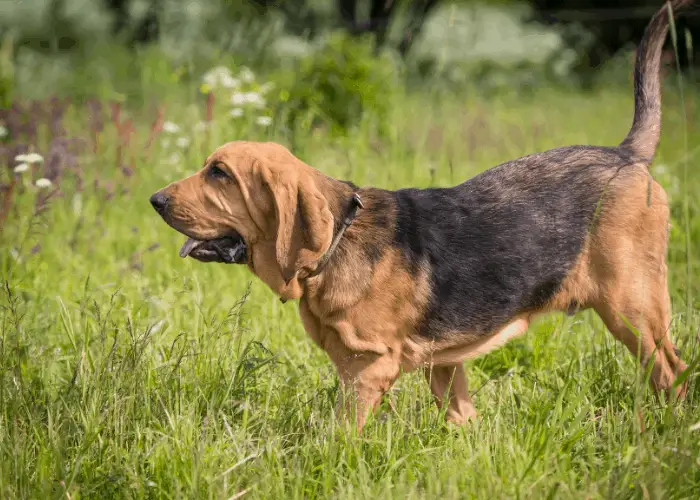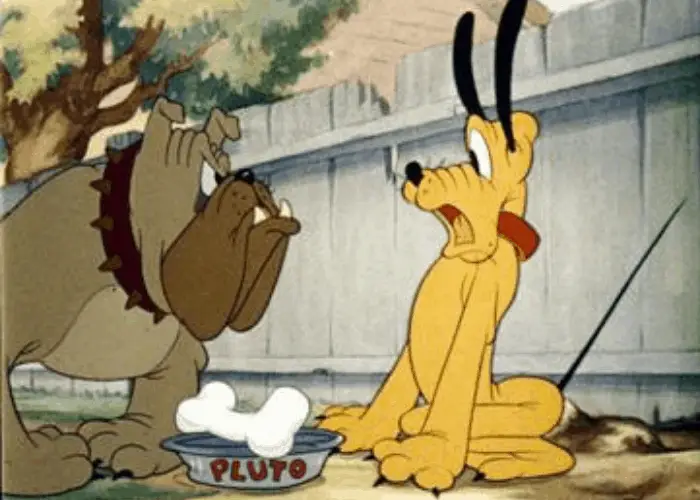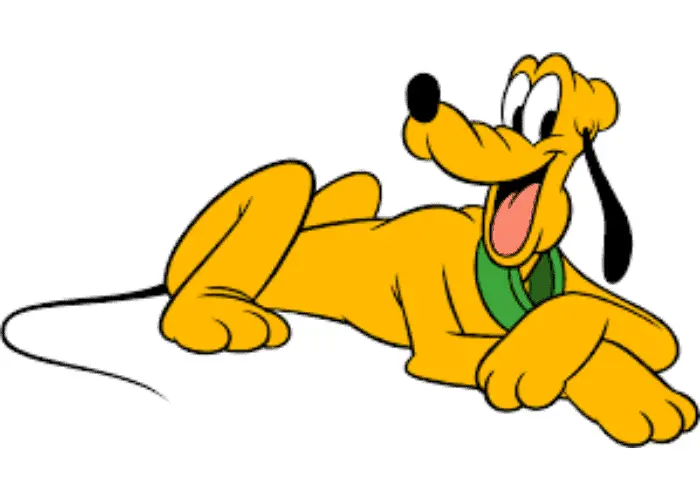Between all the cartoon characters and movie protagonists who are dogs, it can be hard to tell exactly what breed they all are. Some of them have exaggerated features or a lack of characteristics that makes it hard to know their breed. One of the most popular canine cartoon characters is Mickey Mouse’s loyal companion, Pluto. But what kind of dog is he?
Pluto is a Bloodhound. Officially a dog of mixed breed, he was later confirmed to be a Bloodhound after making his first appearance in the 1930’s Mickey Mouse cartoon “The Chain Gang.”
However, a few characteristics make it difficult to know whether he is a pure Bloodhound or more of a mixed breed, as has been said.
We’re going to take a closer look at Pluto as a character, his breed, and what makes him so great. Please keep reading to get all the details on Pluto and what breed of dog he is.
Pluto’s Breed

As we said earlier, Pluto is officially a mixed breed leaning toward Bloodhound heritage. Let’s look at his physical traits and characteristics and see how they match up with the kind of dog he is supposed to represent.
Pluto is shown in cartoons and movies with a yellow or fawn coat, black floppy ears, and a black snout. His coat is short-haired, and he is shown to be a medium-sized dog. The distinct shape of his snout and head also matches up nicely with Hound dogs, having a pronounced roundness to the back of his head.
On top of this, his behavior is very similar to that of Hound dogs. He can often be seen sniffing something out for his owner, Mickey Mouse, and he is shown following his nose to help his friends out. The ability to follow scent trails is a specialty of Hound breeds, especially Bloodhounds, known for their amazing sense of smell.
A Closer Look at Bloodhounds

Bloodhounds are known as “Sleuth Hounds” throughout the world, boasting an impressive sense of smell that allows them to track scent trails extremely well. For this reason, they have been used by law enforcement to track down criminals and have been shown in this capacity in film and TV. Even though Bloodhounds are typically docile and easy-going, they are relentless in tracking a scent.
Bloodhounds can get pretty big, reaching 23 to 27 inches at the shoulder and weighing up to 110 pounds. This makes them one of the larger breeds on the canine size scale.
Some of their well-known physical features include long, floppy ears, wrinkled snouts with loose skin, and eyes set deep into their face, giving them their typical solemn and dignified expressions.
They have powerful legs, which allows them to follow scents over miles of difficult terrain. Bloodhounds are pack dogs, which makes them enjoy the company of other dogs and people. Normally easy-going and laidback, their noses can sometimes get them into trouble when they poke around where they shouldn’t.
If you intend on owning a Bloodhound, you’ll want a strong leash when you take them on walks, as they’ll easily become interested in certain scents and attempt to go off in search of their source.
These dogs can often be unruly, making them difficult to train. They also require a lot of exercise due to their natural tendencies to chase down scents, so you’ll need to be prepared to take them on long walks.
As for what to expect for health-related care issues, Bloodhounds can be susceptible to bloat, just like most large dogs. It will be important to familiarize yourself with this condition and its symptoms, as it can often be life-threatening.
Additionally, because Bloodhounds have such low-hanging ears, you’ll want to check them for infection and irritation frequently. Their ears will often drag on the ground, accumulating dirt and other potential irritants, so you should also be prepared to clean their ears regularly as needed.
For grooming requirements, Bloodhounds have a short-hair coat that is shed twice a year. Giving them a weekly brush with a stiff bristle brush or rubber grooming mitt will remove much of the shedding hair and keep them feeling light and comfortable. This will also minimize the amount of dog hair that they’ll leave around your house.
But what about the history of the Bloodhounds as a breed? While little has been recorded about their history, some scholars have traced their presence to the ancient Mediterranean. It was found that these dogs were used to track prey for the ancient Mediterranean peoples.
Bloodhounds are also responsible for other Hound dog offshoots, like the Black and Tan Coonhound and other varieties of coonhound. We also know that these dogs were fully bred and perfected in ancient Europe, about a thousand years ago.
High-ranking Catholic church officials bred them to exactness to hunt for prey and fugitives running from the law. Since many of the wealthy church officials oversaw their breeding and gave them to nobles, Bloodhounds became known as “blooded hounds,” meaning they were of aristocratic blood.
Since then, Bloodhounds have been used extensively in law enforcement and police work, putting their unrivaled senses of smell to work to catch criminals fleeing the law. They have been proven to be adept at tracking down criminals and lost children or seniors.
Even though their tracking assignments may last a few days, trained Bloodhounds won’t give up a scent trail, often tracking it relentlessly until they find its end. Even in the face of advanced modern-day technology, nothing has been able to replicate the Bloodhound’s unrivaled sense of smell.
Pluto in the Cartoons

Pluto was first introduced to the Mickey Mouse cartoons as a side character before his own series in 1937. He first appeared as a nameless Bloodhound tracking Mickey as he made his escape from prison in the film The Chain Gang, released in 1930. In a film released the following year of 1931, Pluto was introduced as Mickey’s pet dog and named Pluto.
Over the long course of his career as a cartoon canine character, he appeared in 89 films, most of which were shorts released between 1930 and 1953. Many of said films even went on to win Academy Awards for the years they were released, such as the film Lend a Paw, released in 1941.
Because Pluto does not speak (being a true dog, not anthropomorphized like Goofy), he was a pioneering cartoon character in expressing personality through animation instead of dialogue.
As far as Pluto’s characterization goes, he is a fairly normal silent animal companion. He is not given human qualities like Goofy is, not walking upright or wearing any clothes. Because of this, his facial expressions must communicate to the audience every bit of personality he has. And the animators have been able to do this fairly well over the many years.
Have you ever wondered:
Final Thoughts

Pluto is Mickey Mouse’s pet dog, making numerous appearances in a wide selection of Disney shows and films since the early 1900s. As far as his breed goes, he is a Bloodhound, which can be seen from the distinctive features of his face and body.
Bloodhounds are some of the best sniffers globally, able to follow a scent trail for days on end without stopping. We see this sniffer in action many times in the characterization of Pluto, who must rely entirely on animation to communicate his personality, as he doesn’t talk.
We hope we’ve adequately answered all your questions about Pluto and the breed of dog he belongs to, supplementing that question with all you need to know about Bloodhounds. Remember to check our other articles to see what breeds of dogs other popular cartoon canines are.
image credits: image 1: Wikimedia commons
image 2: Wikimedia commons

